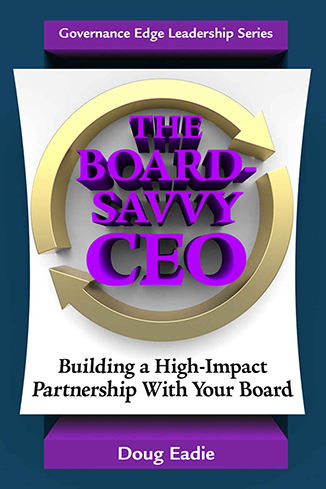 Governing is a team sport if there ever was one. I’ve never in my 30-plus years of working with nonprofit organizations come across a board that has successfully – on its own – transformed itself into a really high-impact governing body, much less managed to carry out its governing responsibilities in a full and timely fashion, without strong executive assistance. High-impact governing is always, in my experience, the product of the board, its CEO, and the senior executives working closely together as a cohesive “Strategic Governing Team.” Of course, we expect the CEO to provide our nonprofit or public organization with capable executive management. We look to our CEO to choose top executives, providing them with direction and assessing their performance, to make sure well-designed administrative systems are in place, etc.
Governing is a team sport if there ever was one. I’ve never in my 30-plus years of working with nonprofit organizations come across a board that has successfully – on its own – transformed itself into a really high-impact governing body, much less managed to carry out its governing responsibilities in a full and timely fashion, without strong executive assistance. High-impact governing is always, in my experience, the product of the board, its CEO, and the senior executives working closely together as a cohesive “Strategic Governing Team.” Of course, we expect the CEO to provide our nonprofit or public organization with capable executive management. We look to our CEO to choose top executives, providing them with direction and assessing their performance, to make sure well-designed administrative systems are in place, etc.
But when a nonprofit or public board chooses its CEO, it’s also choosing the de facto captain of the Strategic Governing Team. Governing really is a collaborative venture, involving intensive, well-orchestrated teamwork to ensure that the decisions and judgments that constitute governing work are made in a full and timely fashion. Your board is obviously the most senior member of the Strategic Governing Team – the ultimate authority, judge and decision maker. However, the CEO has to wear the team captain hat in practice, if not theory, if you want the Strategic Governing Team to be healthy, cohesive, and productive. The reason is simple: TIME the CEO’s and executive team’s and ACCESS TO RESOURCES. No matter how capable, committed, and dedicated board members might be – and experience has taught me they typically are – the fact is that the great majority are part-time, usually unpaid volunteers. Only the CEO has the time (including senior staff’s) to plan for, manage, and support the Strategic Governing Team.
The CEOs who function most effectively as de facto captains of their nonprofits’ Strategic Governing Teams, in my experience, are highly board-savvy. Who are these board-savvy CEOs?
- First and foremost, they bring a very positive and constructive attitude to their work with their boards, seeing the board as both a close colleague and partner in leading and a precious organizational resource. Seeing the board-staff relationship in terms in “we-they” terms is alien to the board-savvy CEO.
- Board-savvy CEOs believe that governing is one of the highest-priority, top-tier CEO functions, albeit shared with their board, and they put their money where their mouth is, devoting significant time and attention to becoming experts in governing and to managing and supporting the governing function.
- They enthusiastically wear the Chief Board Developer hat in their nonprofit organization, embracing systematic board capacity building as one of their critical CEO responsibilities and taking explicit responsibility for making it happen.
- These board-savvy CEOs pay close attention to the emotional and psychological dimension of their Chief Board Developer role, always on the lookout for ways to provide board members with a more satisfying governing experience, primarily by designing processes that actively engage them in shaping high-stakes governing decisions and judgments.
If a board is really committed to playing a high-impact governing role, one of its most important responsibilities is to choose the board-savviest CEO possible when engaged in a CEO search. However, sad to say, many boards in my experience extensively interview CEO candidates without asking probing questions aimed at determining CEO candidates’ board-savviness. It’s not all that difficult for a board to come up with pertinent questions to ask candidates. For example, the board of a local nonprofit economic development corporation I worked with a couple of years ago that was engaged in interviewing CEO candidates came up with such questions as:
- “Would you please define in detail what you think ‘governing’ means?”
- “Broadly speaking, how do you see the board’s role as different from the president/CEO’s?”
- “What were the most important strengths and weaknesses of your last board as a governing body? What did your board do best in governing?”
- “What concrete steps did you take to help your last board develop its governing capacity?”
- “What are the key characteristics of a really solid board-CEO partnership?”
- “What are the most important responsibilities of the board chair? How do you see yourself working with our board chair?”
- What process would you recommend we use to identify our board development needs and issues?
Unfortunately, in my experience many boards just don’t recognize the need to make sure their CEO is really board-savvy . If they luck out, they end up with a CEO who’s board-savvy; but if they don’t, the cost can be quite high, in terms not only of lower-impact governing, but also an unstable board-CEO working relationship that can lead to the CEO’s premature exit.
I drew on my book Extraordinary Board Leadership: The Keys to High-Impact Governing (Jones & Bartlett: Second Edition, 2009) for this post.





